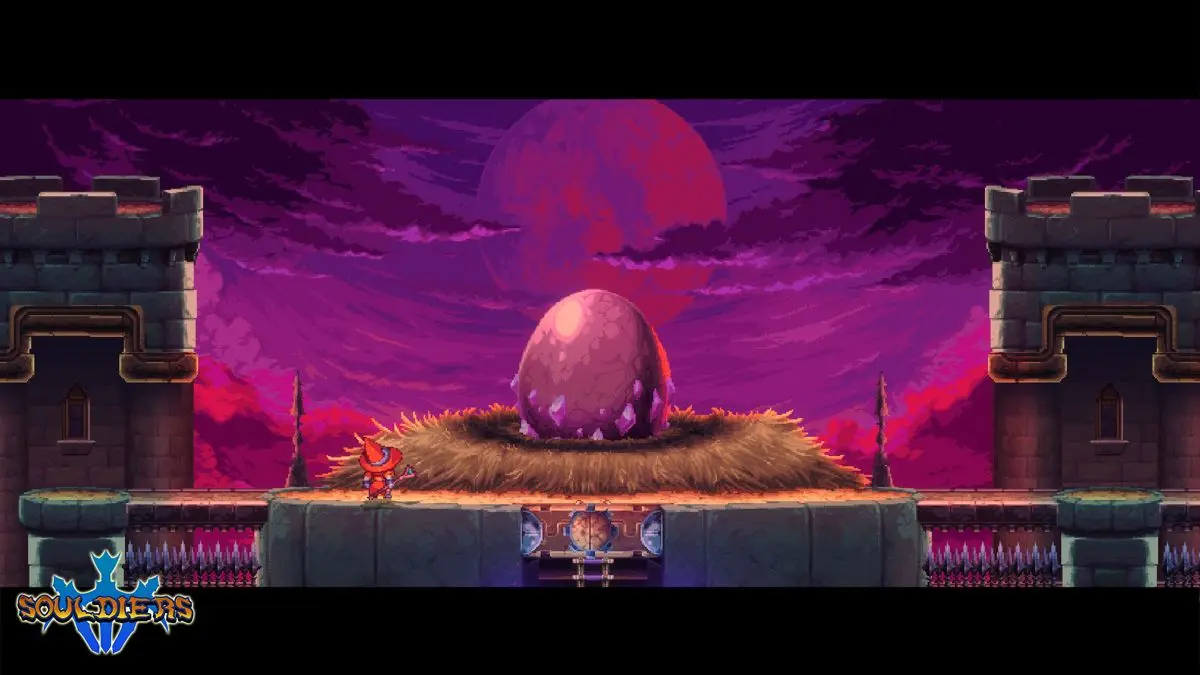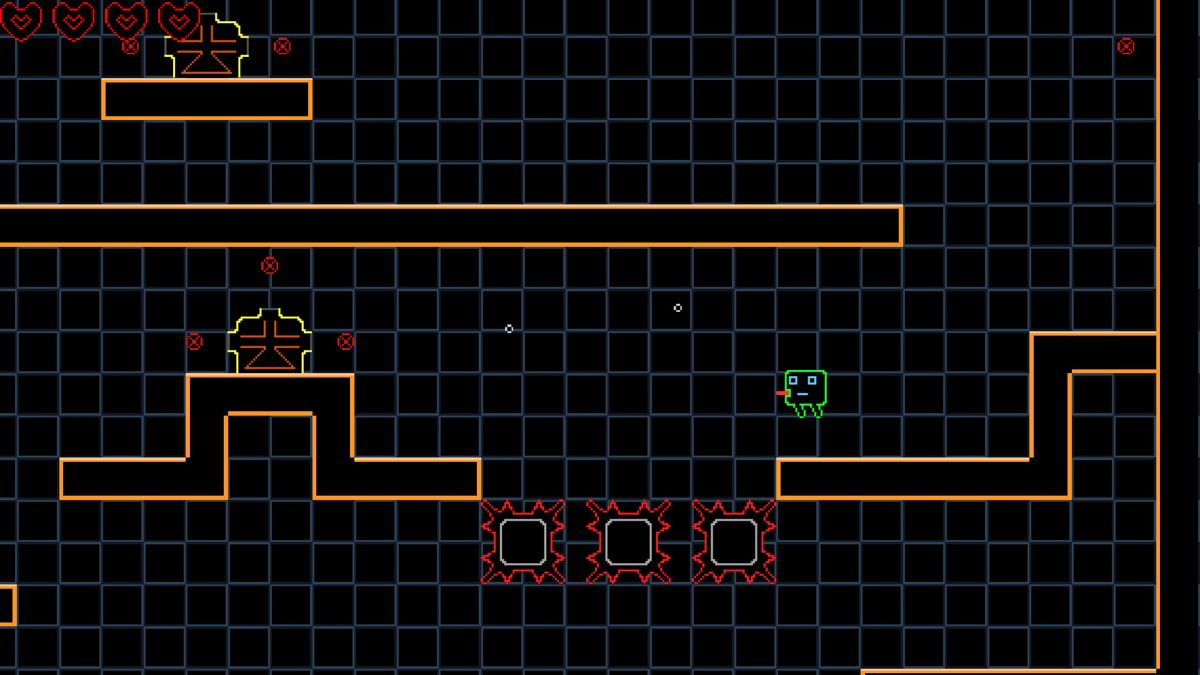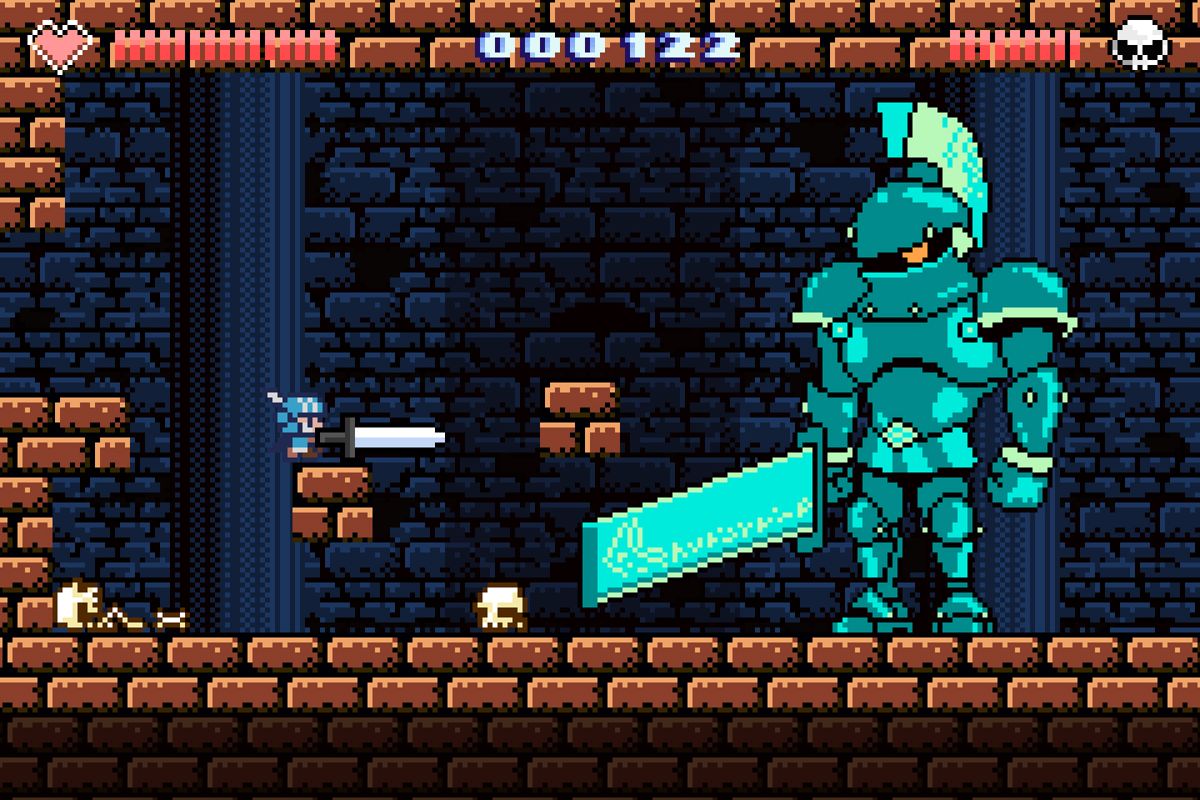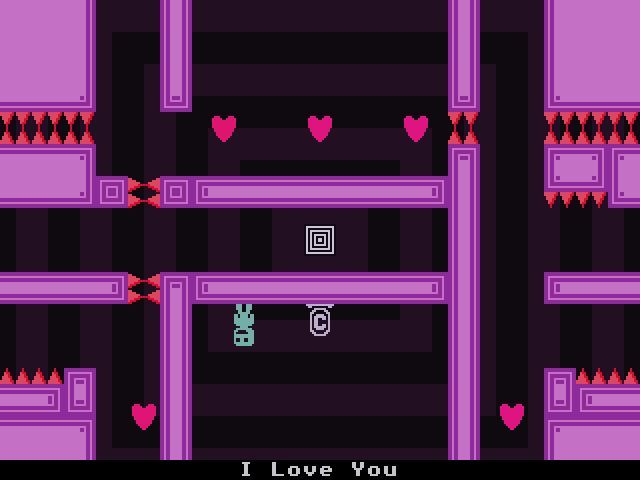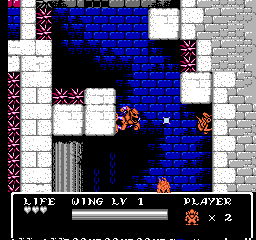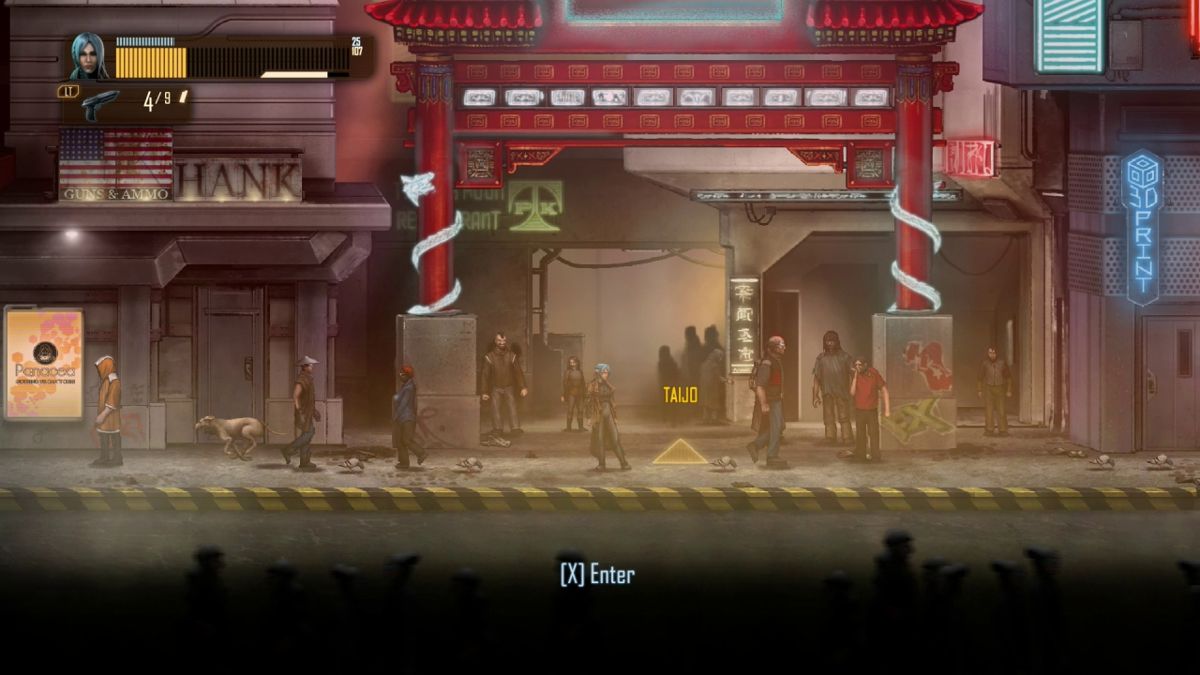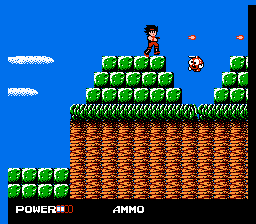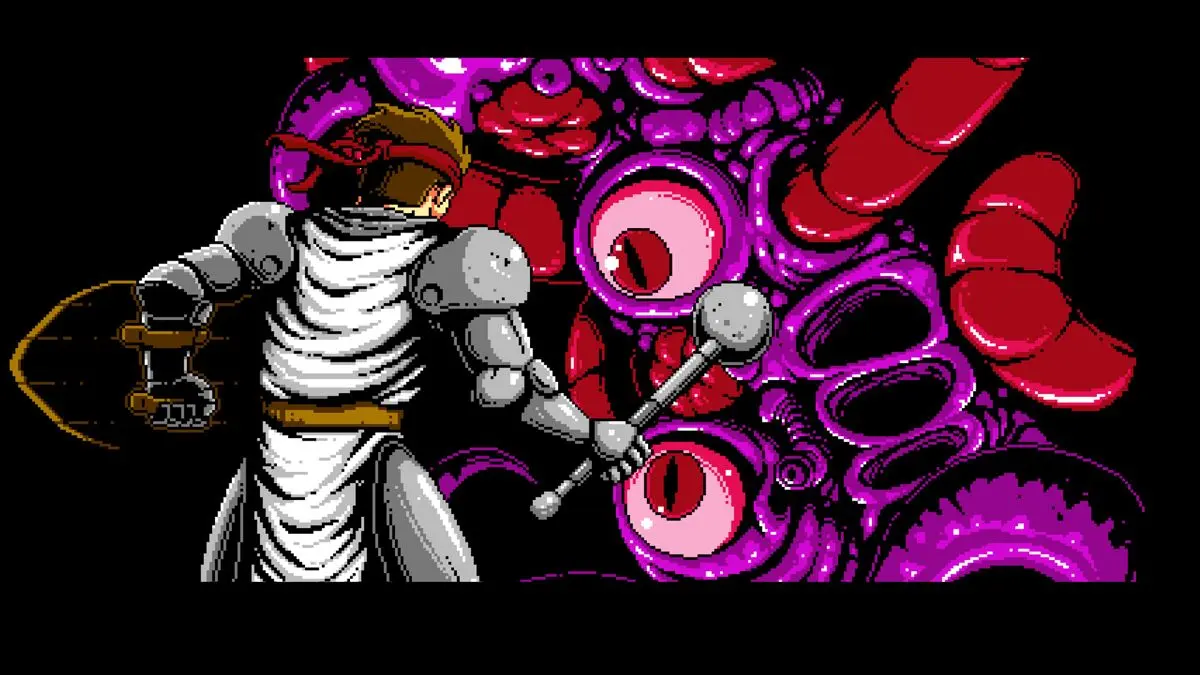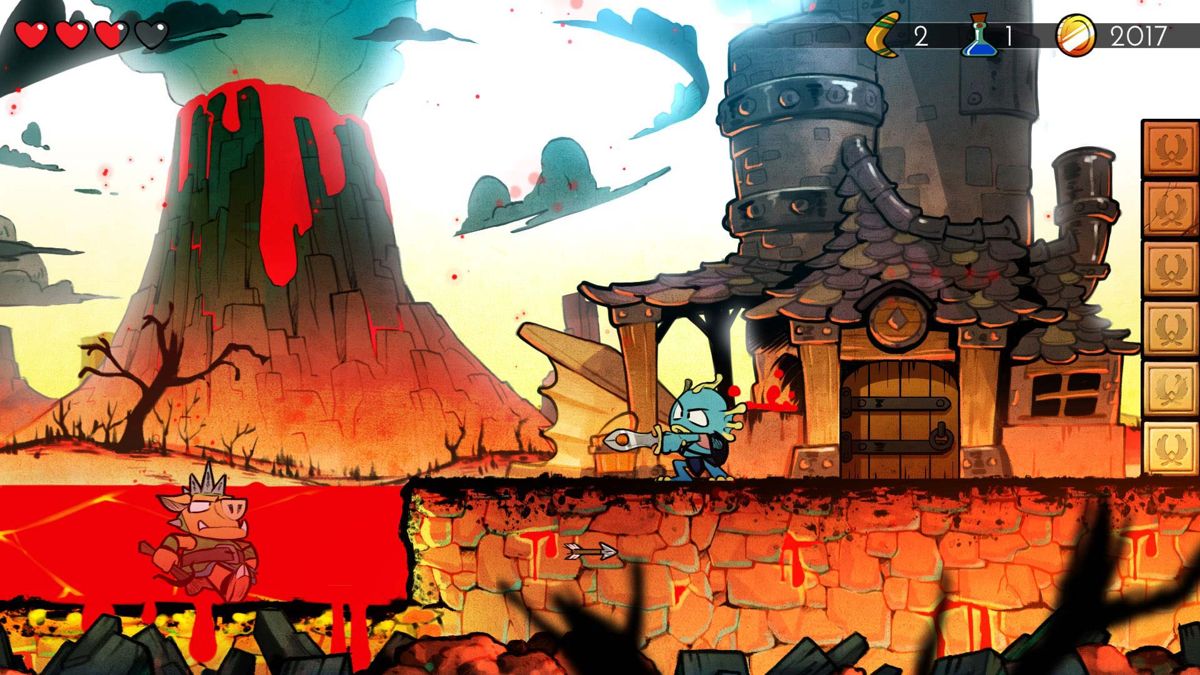Results
Souldiers
corpse runs, fantasy, grindy
Souldiers is a metroidvania-style action platformer that combines intense combat with intricate level designs and a grim, yet captivating narrative. Developed by Retro Forge and Platonic Partnership, the game takes players on a journey through a war-torn world plagued by an enigmatic force known as the Grim Reavers. One of the standout features of Souldiers is its combat system, which emphasizes precision and timing. Players can wield a variety of weapons, each with its own unique moveset and combos. The game encourages players to master the intricacies of each weapon, as well as the ability to seamlessly switch between them mid-combat, creating a fluid and dynamic experience. The level design in Souldiers is a true testament to the developers' creativity and attention to detail. Each area is meticulously crafted, with intricate platforming challenges, hidden secrets, and environmental hazards that demand players to think strategically and adapt their playstyle. The game's emphasis on exploration is enhanced by the ability to unlock new abilities and upgrades, allowing players to backtrack and uncover previously inaccessible areas. Souldiers' narrative is a dark and compelling tale that explores themes of sacrifice, betrayal, and the human condition. Players take on the role of multiple characters, each with their own unique perspectives and motivations, adding depth and complexity to the overarching story. The game's world-building is rich and immersive, with detailed lore and environmental storytelling that invites players to delve deeper into the game's universe. Visually, Souldiers strikes a balance between dark, gritty aesthetics and vibrant, hand-drawn artwork. The game's pixel art style is a masterful blend of technical prowess and artistic flair, creating a distinct and captivating visual experience. The attention to detail in the character designs, enemy animations, and environmental effects is truly remarkable. Overall, Souldiers is a game that excels in delivering a challenging, rewarding, and immersive experience for fans of the metroidvania genre. With its intricate combat system, intricate level design, compelling narrative, and stunning visuals, Souldiers stands out as a must-play title for those seeking a deep and engaging action-platformer experience.
Dungeon of Zolthan
fantasy, grindy, environmental puzzles
Dungeon of Zolthan is a first-person dungeon crawler RPG developed by Frogdice and released in 2016. While it follows the familiar formula of exploring procedurally generated dungeons, looting treasures, and battling various monsters, the game sets itself apart with its emphasis on character customization and deep mechanics. Character progression is heavily influenced by the player's choice of race, class, and skill allocation. The game features a diverse array of playable races, each with unique racial traits and abilities that significantly impact playstyle. Class selection is equally crucial, with options ranging from traditional archetypes like warriors and mages to more unconventional choices like alchemists and shadow dancers. Combat in Dungeon of Zolthan is a tactical affair, with a robust combat system that encourages careful positioning, resource management, and situational awareness. Enemies possess distinct behaviors and abilities, requiring players to adapt their strategies accordingly. The game also features an intricate magic system, with a wide range of spells that can be combined and customized to create powerful synergies. One of the game's standout features is its commitment to replayability. In addition to the randomly generated dungeons, the game features multiple difficulty levels, challenge modes, and a New Game+ option that allows players to carry over their progress and equipment into subsequent playthroughs. This, combined with the vast character customization options, ensures that each playthrough feels fresh and engaging. The game's world-building and lore are also noteworthy, with a rich backstory and detailed environmental design that immerses players in the Dungeon of Zolthan's dark and foreboding atmosphere. The game's presentation, while not groundbreaking, is consistent and visually appealing, with intricate character models and atmospheric lighting effects. Overall, Dungeon of Zolthan offers a deep and rewarding experience for fans of the dungeon crawler genre, with its emphasis on customization, tactical combat, and replayability ensuring that it stands out from the crowd.
Castle in the Darkness
fantasy, challenging, hidden areas
Castle in the Darkness (2015) is a Metroidvania-style action-platformer developed by BEHNAVSH. While it follows the familiar formula of the genre, it distinguishes itself with its unique aesthetic and atmospheric horror elements. The game's pixelated art style is heavily inspired by the Philips Videopac+ and Atari 2600 era, with a limited color palette and chunky sprites. However, the visuals are more than just a nostalgic throwback, as they effectively contribute to the game's unsettling and eerie ambiance. The game's narrative is minimalistic, leaving much to the player's interpretation. You take on the role of a nameless protagonist who finds themselves trapped within the confines of a foreboding castle. As you explore the labyrinthine corridors and interconnected rooms, you'll uncover clues about the castle's dark history and the fate of its former inhabitants. One of the standout features of Castle in the Darkness is its emphasis on environmental storytelling. The game's world is meticulously crafted, with each area conveying a distinct atmosphere and revealing snippets of lore through carefully placed details and imagery. Combat in the game is challenging but satisfying, requiring precise timing and strategic use of your character's limited arsenal. Enemies are varied and often pose unique threats, forcing you to adapt your playstyle and approach encounters tactically. In addition to combat, the game features intricate platforming sequences and puzzles that often require backtracking and utilizing newly acquired abilities or items. This encourages exploration and rewards players who take the time to uncover the castle's hidden secrets. While Castle in the Darkness may initially seem like a straightforward retro-inspired platformer, its atmospheric horror elements, environmental storytelling, and challenging gameplay make it a standout entry in the Metroidvania genre.
VVVVVV
environmental puzzles, sci-fi, pixel art
VVVVVV is a challenging and ingenious 2D platformer developed by Terry Cavanagh. While its retro-inspired 8-bit graphics and chiptune soundtrack might seem deceptively simple, the game's core mechanic sets it apart from most traditional platformers. Instead of jumping, the player reverses the direction of gravity, allowing them to navigate intricate levels by flipping between the floor and ceiling. This mechanic introduces a unique level of complexity, requiring precise timing and spatial awareness to navigate hazardous obstacles and tricky room designs. The game's level design is masterfully crafted, gradually increasing in difficulty and introducing new mechanics and obstacles that force players to adapt their strategies. From spike-filled rooms to crumbling platforms and teleporters, each new challenge tests the player's reflexes and problem-solving skills. Despite its punishing difficulty, VVVVVV's level progression is well-balanced, providing a sense of accomplishment with each cleared room. The game also includes a plethora of hidden collectibles and secret areas, encouraging exploration and rewarding players for their curiosity and perseverance. One of the game's standout features is its narrative, which unfolds through cryptic text interludes and environmental storytelling. While initially appearing as a simple rescue mission, the plot takes unexpected turns, adding depth and mystery to the game's world. VVVVVV's minimalist yet charming presentation, coupled with its innovative gravity-flipping mechanics and meticulously designed levels, solidified its status as a cult classic among indie game enthusiasts and a benchmark for challenging yet rewarding platformers.
Gargoyle's Quest II
fantasy, pixel art, challenging
Gargoyle's Quest II, released in 1992 for the Game Boy, is a sequel to the original Gargoyle's Quest and a spin-off from the Ghosts 'n Goblins series. Unlike its predecessor, which was a straightforward platformer, Gargoyle's Quest II incorporates elements of action RPGs and Metroidvania-style exploration. The game takes place in the same world as its predecessor, but the story follows a different protagonist, a red gargoyle named Firebrand. The narrative revolves around Firebrand's quest to stop the resurrection of the powerful King Breager, who seeks to conquer the world. One of the standout features of Gargoyle's Quest II is its non-linear level design. The game world is interconnected, with various routes and paths that can be unlocked by acquiring new abilities or items. This encourages backtracking and exploration, as players must revisit previously inaccessible areas to progress. The combat system is significantly enhanced compared to the first game. Firebrand can now equip a variety of weapons and armor, each with unique attributes and abilities. This adds depth to the gameplay and allows for customization and strategic decision-making. Another notable aspect of Gargoyle's Quest II is its difficulty. The game is known for its challenging boss battles and intricate level design. Enemies are formidable, and players must use their wits and skills to overcome obstacles and navigate treacherous environments. Visually, the game features detailed sprite work and diverse environments, ranging from dense forests to underground caverns and ancient ruins. The soundtrack, composed by Kenichi Matsubara, is widely praised for its memorable melodies and atmospheric nature. While not as well-known as other Metroidvania classics, Gargoyle's Quest II has garnered a cult following among retro enthusiasts and is celebrated for its pioneering approach to non-linear exploration and RPG elements in a handheld game of its era.
Dex
environmental puzzles, sci-fi, pixel art
Dex (2015) is a cyberpunk-themed, side-scrolling RPG developed by Dreadlocked Games and Badland Games. While it features a vibrant, pixel art aesthetic reminiscent of classic 16-bit titles, Dex offers a refreshingly mature storyline and intricate gameplay mechanics that set it apart from the typical retro-inspired platformer. The game is set in the dystopian, neon-drenched metropolis of Harbor Prime, a corporate-controlled city where augmented reality has become the norm. You play as Dex, a skilled hacker who finds herself embroiled in a conspiracy that threatens to unravel the fabric of this cyberpunk society. The narrative is non-linear, with multiple branching paths and endings that are influenced by your choices and actions throughout the game. Dex's combat system is a unique blend of real-time action and turn-based strategy. While traversing the environments, you'll engage in fast-paced platforming sequences, but once combat initiates, the action shifts to a turn-based format where you must strategically deploy your character's abilities and resources. This hybrid system keeps the gameplay fresh and engaging, requiring you to master both agility and tactical decision-making. One of Dex's standout features is its impressive depth of character customization and progression. As you level up, you can allocate skill points across a vast array of abilities, ranging from hacking and stealth to combat and social skills. This flexibility allows you to tailor Dex's capabilities to your preferred playstyle, whether you favor a stealthy approach, brute force, or a balanced blend of both. The game's world is densely populated with NPCs, each with their own backstories and agendas. Engaging in dialogue and side quests can reveal valuable information, unlock new paths, or even grant unique abilities, encouraging players to explore every nook and cranny of Harbor Prime. Overall, Dex offers a captivating cyberpunk adventure that successfully blends retro aesthetics with modern gameplay mechanics and storytelling. Its intricate world-building, branching narrative, and deep customization systems make it a standout title within the indie RPG genre.
Clash at Demonhead
shooter, pixel art, challenging
Clash at Demonhead, released in 1989 for the NES, was a unique and ambitious action-adventure game that stood out from its contemporaries. Developed by Vic Tokai, it combined elements of role-playing games, platformers, and maze navigation in a distinctive way. One of the game's most notable features was its non-linear structure, allowing players to explore the vast interconnected overworld and dungeons in a relatively open-ended manner. This freedom of exploration was complemented by the ability to backtrack and revisit previously inaccessible areas as new abilities were acquired. The game's combat system was also unconventional for its time. Instead of relying on traditional hack-and-slash mechanics, players had to strategically position themselves relative to enemies and time their attacks carefully. This added an extra layer of challenge and required players to master the nuances of combat. Clash at Demonhead's narrative was another standout aspect. While the premise of a hero battling evil forces was standard fare, the game's storytelling was enhanced by its use of cinematic cut-scenes and a memorable cast of characters, including the enigmatic and formidable villain, Demonhead. The game's visual style, with its detailed sprites and atmospheric backgrounds, was also noteworthy, creating a distinct and immersive world. Additionally, the game's soundtrack, composed by Masahiko Kawashima, was praised for its melodic and atmospheric qualities, adding to the overall ambiance. While Clash at Demonhead may have been overshadowed by some of its more popular contemporaries, it remains a cult classic among retro gaming enthusiasts, appreciated for its ambitious design, challenging gameplay, and unique blend of genres that set it apart from the norm.
Infernax
fantasy, pixel art, challenging
Infernax is a retro-inspired action-adventure platformer that pays homage to the classic 8-bit era, particularly the Castlevania series. While the game's pixel art graphics and side-scrolling gameplay evoke a strong sense of nostalgia, it distinguishes itself with its unique blend of genres and challenging gameplay mechanics. One of the standout features of Infernax is its emphasis on exploration and non-linear level design. Players are encouraged to backtrack and uncover hidden paths, secret rooms, and optional challenges that reward them with powerful upgrades and loot. The game's world is interconnected, with multiple routes and shortcuts to discover, adding depth to the exploration aspect. The combat system in Infernax is unforgiving and requires precise timing and strategy. The game features a unique combo system that rewards players for skillful execution, allowing them to chain attacks for increased damage and special effects. One of the notable elements of Infernax is its dark and oppressive atmosphere. The game draws inspiration from occult and satanic themes, presenting a bleak and foreboding world overrun by demonic forces. The narrative unfolds through environmental storytelling and cryptic notes scattered throughout the game, leaving players to piece together the lore and unravel the mysteries surrounding the protagonist's quest. Infernax also incorporates elements of RPGs, with a leveling system that allows players to improve their character's stats and unlock new abilities. However, the game maintains a challenging difficulty level, ensuring that players must master their skills and strategize effectively to progress. Overall, Infernax delivers an authentic retro experience while incorporating modern design elements and a unique blend of genres. Its emphasis on exploration, challenging combat, and dark atmospheric storytelling make it a standout title for fans of classic action-adventure games and those seeking a fresh take on the genre.
Wonder Boy: The Dragon's Trap
fantasy, pixel art, challenging
Wonder Boy: The Dragon's Trap (2017) is a remarkable reimagining of the classic Wonder Boy III: The Dragon's Trap (1989) for the Sega Master System. This metroidvania-style action-platformer pays homage to the original while introducing stunning hand-drawn visuals and modern quality-of-life improvements. The game retains the core gameplay mechanics of the original, where players control a adventurer who has been cursed to transform into various creatures, each with unique abilities. The transformations play a crucial role in navigating the intricate levels, solving puzzles, and overcoming formidable bosses. However, the developers have added new mechanics, such as the ability to freely switch between the original 8-bit graphics and the gorgeous hand-drawn art style with the press of a button. One of the standout features of this remake is the attention to detail in the visuals. The levels are beautifully rendered, with intricate backgrounds and character animations that breathe new life into the classic adventure. The developers have also expanded on the original game's lore, adding new story elements and character interactions that enhance the narrative depth. While remaining faithful to the original's level design, the developers have made subtle adjustments to improve the overall experience. Checkpoints have been strategically placed, and the difficulty curve has been fine-tuned, making the game more accessible to modern players while retaining the challenge that made the original a cult classic. The soundtrack, composed by legendary chiptune artist Michiru Yamane, is a masterful blend of remixed and reimagined tracks from the original game, complementing the visuals and adding to the nostalgic charm. Wonder Boy: The Dragon's Trap (2017) is a masterclass in how to revive a beloved classic while respecting its legacy and introducing modern sensibilities. It's a must-play for fans of the original and newcomers alike, offering a captivating adventure that seamlessly blends retro charm with contemporary refinements.
Filters
Search Term
Properties
Platforms
Tags (include)
Tags (exclude)
Get Your Game Noticed
Advertise your game with MetroidvaniaDB and reach a community of people who know exactly what they're looking for:
Your game.
Native & Banner Ad Spots
Multi-week Discounts
Game Launch Packages
Discounts for Indie Developers

